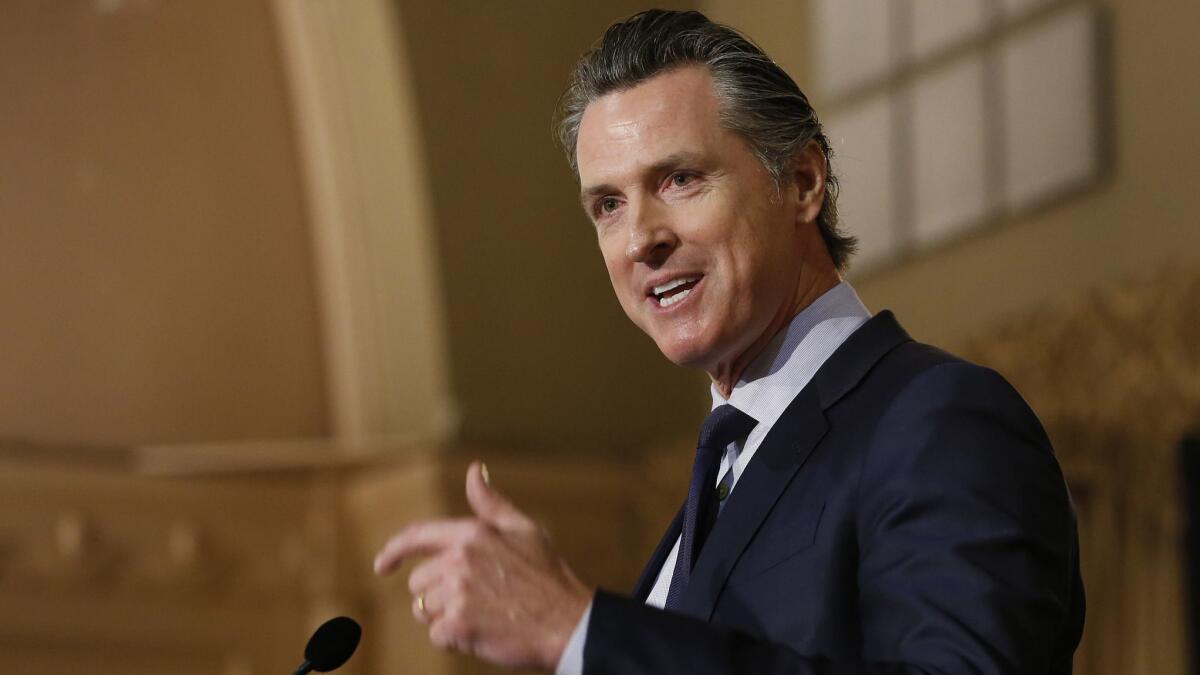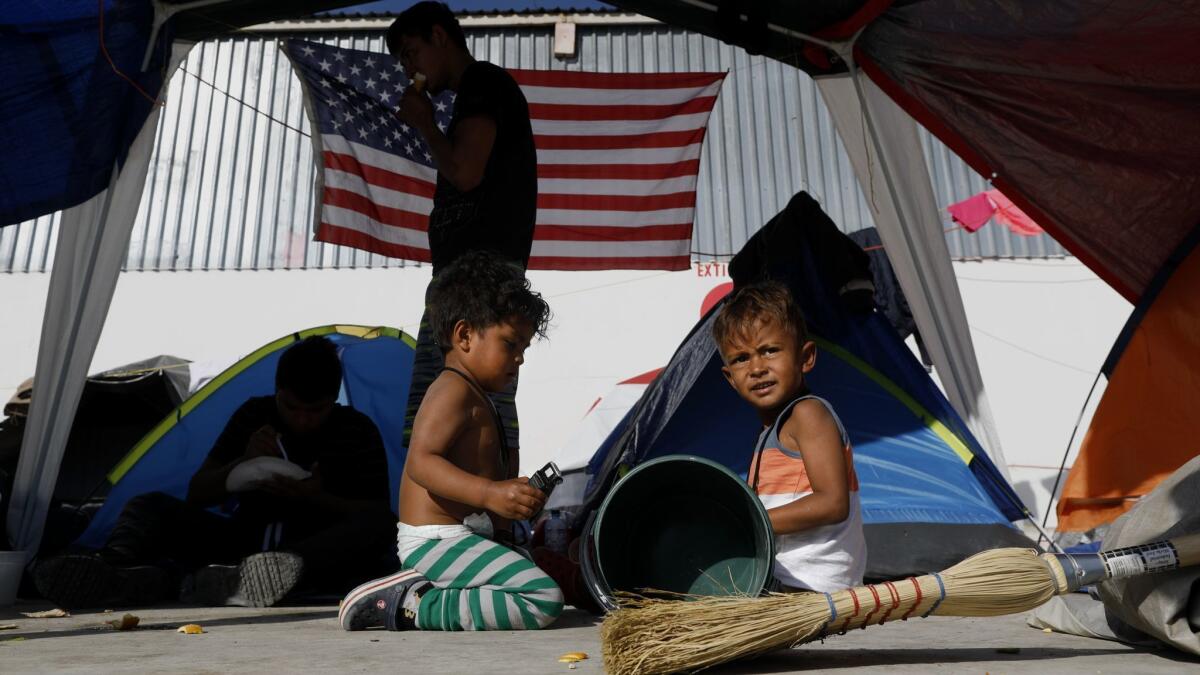Gov. Gavin Newsom touts proposed $25 million in California aid to asylum seekers

- Share via
Reporting from San Diego — Gov. Gavin Newsom and local officials in San Diego on Thursday touted a proposed $25 million in state funding to address a growing humanitarian crisis involving migrant families seeking asylum in the U.S. and blamed the Trump administration for manufacturing a problem at the border.
With prodding from San Diego lawmakers, Newsom has called for spending $20 million over three years to aid local nonprofits and community organizations that provide services to asylum-seeking migrant families. The funds would be available starting in the state fiscal year that begins in July.
The governor has also asked the Legislature for another $5 million in immediate funding, which lawmakers plan to approve in the coming weeks.
“Unfortunately, [for] the current administration, this is self-induced,” Newsom said of border conditions at a news conference in San Diego. “It’s a policy they advanced in October that [has] made the conditions not only worse here in California but [has] been highlighted in places like El Paso and elsewhere where they are having exactly the same kind of challenges.”

Although crucial to nonprofits working to provide services to an influx of Central American migrant families arriving in San Diego, the proposed spending constitutes a small fraction of Newsom’s $209-billion state budget, which he unveiled this month.
The funding is largely expected to help the San Diego Rapid Response Network — a coalition of more than two dozen nonprofits — to provide shelter, food and other services to asylum seekers being released onto city streets.
Thursday’s trip served as another opportunity for Newsom to highlight the stark divide on immigration policy between California and the Trump administration.
“He’s trying to address a real problem, but he’s also very clearly trying to point a finger at the Trump administration by saying, ‘Not on my watch; not on California’s watch,’ ” said Brad Jones, professor of political science at UC Davis.
Members of the San Diego Rapid Response Network have criticized the Trump administration’s treatment of refugees at the border.
Before last fall, the federal government processed and held asylum-seeking families for up to several days while helping them make travel arrangements with sponsors, mostly in other states. The Trump administration ended the so-called safe release policy last October and began releasing migrants after registration and before they connect with sponsors.
The administration has also registered asylum seekers more slowly, creating a bottleneck at the border, said Kevin Malone, executive director of the San Diego Organizing Project, a member of the coalition.
“It’s a manufactured crisis to feed this narrative of crisis at the border,” Malone said.
Newsom, standing next to several state and local officials, applauded community groups and nonprofits for taking action to address the problem and said the state only intervened after the groups stepped up. As a small group of protesters, one wearing a “Make America Great Again” hat, gathered outside, Newsom stressed that the migrant families seeking asylum in the U.S. are following immigration law.
“It’s an example, a repudiation, of that assertion that somehow these caravans are coming in to create havoc and do something as some would suggest are not in line with our values,” Newsom said.
The news conference came less than a week after Trump agreed to temporarily end the longest government shutdown in U.S. history, without securing the more than $5 billion he demanded for a new border wall.
It was also the second jab in as many weeks Newsom has made against the president’s agenda. In mid-January, the governor met with Transportation Security Administration workers in Sacramento during the shutdown and pledged to provide state unemployment benefits to essential employees who were required to work without pay. The Trump administration advised California and other states that the employees were ineligible for the benefits before Newsom invited reporters to join him to talk with the TSA employees.
Newsom’s focus on helping immigrants includes a budget proposal to expand Medi-Cal coverage in California to young immigrant adults without legal status under age 26 — at a cost of $260 million next year — in a move that drew criticism from Washington.
Though former Gov. Jerry Brown played a critical role in the California-versus-Trump saga, Jones said Newsom is taking it to another level.
“Newsom is really trying to put California on the map in terms of doubling down on pro-immigration, pro-immigrant policies that are squarely opposed by Donald Trump,” Jones said.
The president took to Twitter on Thursday to lament an increase in murders in Mexico last year. At the same time, his administration is taking a new stance that those who apply for asylum must remain in Mexico as the U.S. makes a determination on their cases.
“This is a big contributor to the Humanitarian Crisis taking place on our Southern Border and then spreading throughout our Country,” Trump tweeted. “Worse even than Afghanistan. Much caused by DRUGS. Wall is being built!”
As the president continues to ramp up his rhetoric on border safety, nonprofits have sought to provide shelter to immigrants with little financial help from either the state or local government. Representatives of Jewish Family Service of San Diego, which operates a shelter to house migrants, said the organization has moved to five different locations since first opening last fall.
The facility temporarily shelters asylum seekers for less than 72 hours before they travel to meet family members outside San Diego. The San Diego Rapid Response Network has so far assisted more than 5,000 migrants with transportation assistance and humanitarian aid.
Malone said the coalition has worked closely with Senate President Pro Tem Toni Atkins (D-San Diego) and Assemblywoman Lorena Gonzalez Fletcher (D-San Diego) to draw Newsom’s attention to the problem.
In late November, U.S. Immigration and Customs Enforcement officials warned the coalition that more than 200 people would be processed and released in a single day, Malone said. The shelter was already housing at least 60 migrants when another 170 arrived.
The next morning, then-Gov.-elect Newsom, his wife, Jennifer Siebel Newsom, and Chief of Staff Ann O’Leary arrived to visit the shelter, which was then housed at a Salvation Army. Malone called it “serendipitous.”
“He and the first partner and his chief of staff showed up at our shelter on the worst day,” Malone said. “The guy teared up. It was real. He was walking around seeing these tiny little children and families everywhere. He committed right there. They both felt it.”
Weeks later, at a news conference to unveil his budget, the governor talked about meeting a 3-year-old girl — a year younger than his son Dutch — at the shelter who touched his heart.
Since then the San Diego County Board of Supervisors has stepped in and on Tuesday agreed to allow a vacant family courthouse to be used as a temporary shelter for asylum seekers. Under the agreement with Jewish Family Service, the nonprofits will be able to operate a shelter for asylum-seeking families in the building until the end of the year. Newsom toured the new site with local officials Thursday.
The San Diego Rapid Response Network said the $5 million in immediate state funds would help cover costs of opening, operating and maintaining the shelter through the end of the year.
Malone said the group hopes some of the proposed $20 million, which will probably be shared with other nonprofits, can be used to establish a long-term fix and fund a permanent shelter in the years to come.
Luna reported from Sacramento. Clark writes for the San Diego Union-Tribune and reported from San Diego.
Twitter: @tarynluna
More to Read
Get the L.A. Times Politics newsletter
Deeply reported insights into legislation, politics and policy from Sacramento, Washington and beyond. In your inbox three times per week.
You may occasionally receive promotional content from the Los Angeles Times.











